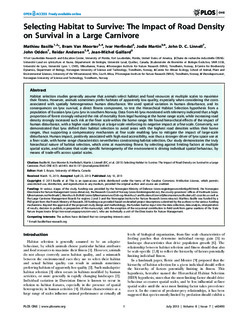| dc.contributor.author | Basille, Mathieu | |
| dc.contributor.author | Van Moorter, Bram F. A. | |
| dc.contributor.author | Herfindal, Ivar | |
| dc.contributor.author | Martin, Jodie | |
| dc.contributor.author | Linnell, John Durrus | |
| dc.contributor.author | Odden, John | |
| dc.contributor.author | Andersen, Reidar | |
| dc.contributor.author | Gaillard, Jean-Michel | |
| dc.date.accessioned | 2015-11-24T08:17:23Z | |
| dc.date.accessioned | 2015-12-10T10:29:22Z | |
| dc.date.available | 2015-11-24T08:17:23Z | |
| dc.date.available | 2015-12-10T10:29:22Z | |
| dc.date.issued | 2013 | |
| dc.identifier.citation | PLoS ONE 2013, 8(7) | nb_NO |
| dc.identifier.issn | 1932-6203 | |
| dc.identifier.uri | http://hdl.handle.net/11250/2367442 | |
| dc.description.abstract | Habitat selection studies generally assume that animals select habitat and food resources at multiple scales to maximise their fitness. However, animals sometimes prefer habitats of apparently low quality, especially when considering the costs associated with spatially heterogeneous human disturbance. We used spatial variation in human disturbance, and its consequences on lynx survival, a direct fitness component, to test the Hierarchical Habitat Selection hypothesis from a population of Eurasian lynx Lynx lynx in southern Norway. Data from 46 lynx monitored with telemetry indicated that a high proportion of forest strongly reduced the risk of mortality from legal hunting at the home range scale, while increasing road density strongly increased such risk at the finer scale within the home range. We found hierarchical effects of the impact of human disturbance, with a higher road density at a large scale reinforcing its negative impact at a fine scale. Conversely, we demonstrated that lynx shifted their habitat selection to avoid areas with the highest road densities within their home ranges, thus supporting a compensatory mechanism at fine scale enabling lynx to mitigate the impact of large-scale disturbance. Human impact, positively associated with high road accessibility, was thus a stronger driver of lynx space use at a finer scale, with home range characteristics nevertheless constraining habitat selection. Our study demonstrates the truly hierarchical nature of habitat selection, which aims at maximising fitness by selecting against limiting factors at multiple spatial scales, and indicates that scale-specific heterogeneity of the environment is driving individual spatial behaviour, by means of trade-offs across spatial scales. | nb_NO |
| dc.language.iso | eng | nb_NO |
| dc.publisher | Public Library of Science | nb_NO |
| dc.title | Selecting habitat to survive: The impact of road density on survival in a large carnivore | nb_NO |
| dc.type | Journal article | nb_NO |
| dc.type | Peer reviewed | en_GB |
| dc.date.updated | 2015-11-24T08:17:23Z | |
| dc.source.volume | 8 | nb_NO |
| dc.source.journal | PLoS ONE | nb_NO |
| dc.source.issue | 7 | nb_NO |
| dc.identifier.doi | 10.1371/journal.pone.0065493 | |
| dc.identifier.cristin | 1044115 | |
| dc.relation.project | Norges forskningsråd: 223257 | nb_NO |
| dc.description.localcode | © 2013 Basille et al. This is an open-access article distributed under the terms of the Creative Commons Attribution License, which permits unrestricted use, distribution, and reproduction in any medium, provided the original author and source are credited. | nb_NO |
